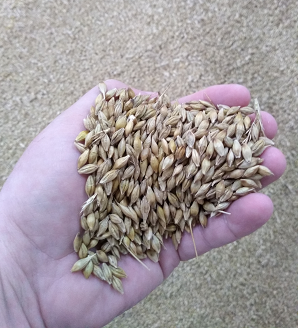Considerations for Feeding Barley this Winter
30 September 2025The spring barley crop has been significantly affected by the dry weather this summer, resulting in high screenings and high nitrogen. As a result, much of what would normally be destined for malting is ending up in the feed market. With barley being cheap and plentiful in supply, farmers that have traditionally sold forward stores, may be thinking about a move towards intensive finishing if shed space allows. Ad-lib feeding with cereals will also be an attractive option where silage stocks are in short supply.
Analyse your Barley
Given the variation in barley quality, it is recommended that you analyse your barley to check the nitrogen content and hence protein content. The difference between a 1.4% N and 1.8%N is a protein level of either 8.75% or 11.25% (on a dry matter basis). With the lower level of N, that means about an EXTRA 0.9kg/head/day of rapemeal required compared to the higher level of N for the same animal performance for a 600kg bull ration.
In addition, the dry matter of barley will influence fresh weight intake so be sure to tell your nutritionist this information when formulating a ration. Barley alone is not a balanced ration; it is too high in starch (above 50%) and not adequate in protein. An additional protein source will need to be fed with the barley. High protein supplements (above 50% crude protein) are likely to contain urea and require to be fed in small amounts. This is also higher risk, as a greater percentage of barley is being fed. Lower risk are mid-high (20-40% crude protein) protein sources, either bought as straights such as dark grains or rapemeal, or as a purpose made compound feed or blend. Seek advice on levels based on the barley being fed and the feeding system in place. Mineral supplementation is crucial in an ad-lib barley based feeding regime; especially important are calcium, salt, vitamins and trace elements.

Finishing Cattle on Ad-lib Cereal Rations
For those that haven’t finished cattle intensely on ad- lib cereal rations before, here are some important considerations for protecting rumen health (avoiding acidosis) and maintaining good growth rates:
- Avoid overprocessing barley – this can be difficult with dried barley, which shatters more easily. The grain just needs to be lightly cracked for cattle to digest.
- Build up to ad lib intakes over a period of at least three to four weeks. Take nutritional advice on making up a home mix and transitioning cattle to ad lib concentrate feeding.
- Never allow the hopper to run empty of feed. This increases risk of cattle gorging the next time the hopper is filled up, leading to potential acidosis.
- Allow good feed access, especially during the adaptation period so that all cattle can eat at once. Poor access means that less dominant animals will eat fewer, larger feeds, again potentially setting themselves up for acidosis.
- Clean water and straw must always be available. Do not rely on straw from bedding alone. Long straw is best to encourage good cudding behaviour, which promotes saliva production to help buffer the acidity in the rumen.
- During the initial period on ad lib, it may be worth considering the use of a rumen buffer or yeast product in the mix to help minimise acidosis risk. A yeast product will also have the further benefit of improved feed conversion efficiency and trials indicate an improvement of daily liveweight gain in the region of 10%.
Be Mindful When Weighing Out Rations
Barley may be lighter this year due to the variation in quality. Rso remember that grain with a low specific weight occupies a greater volume for a given weight compared to normal grain, which means less grain weight in a bag or bucket. Check you are feeding enough by weighing bags/buckets to ensure you are feeding the amount expected.
In addition, bruising/rolling grains will exaggerate the difference as processed grains are less dense than whole grains. As well the weight of the grain, the dry matter also makes a difference on how much needs to be fed to meet animal requirements for a given level of performance. It is crucial to discuss barley specification when formulating rations alongside your nutritionist.
Lorna Shaw, SAC Consulting ; lorna.shaw@sac.co.uk
Sign up to the FAS newsletter
Receive updates on news, events and publications from Scotland’s Farm Advisory Service

